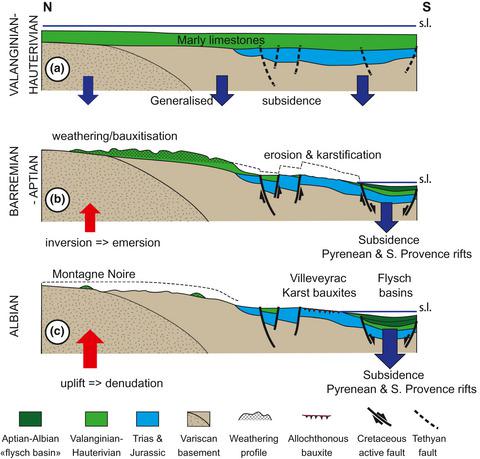当前位置:
X-MOL 学术
›
Basin Res.
›
论文详情
Our official English website, www.x-mol.net, welcomes your
feedback! (Note: you will need to create a separate account there.)
LA‐ICP‐MS dating of detrital zircon grains from the Cretaceous allochthonous bauxites of Languedoc (south of France): Provenance and geodynamic consequences
Basin Research ( IF 2.8 ) Pub Date : 2020-06-04 , DOI: 10.1111/bre.12465 Emilie Marchand 1, 2 , Michel Séranne 2 , Olivier Bruguier 2 , Marc Vinches 1
Basin Research ( IF 2.8 ) Pub Date : 2020-06-04 , DOI: 10.1111/bre.12465 Emilie Marchand 1, 2 , Michel Séranne 2 , Olivier Bruguier 2 , Marc Vinches 1
Affiliation

|
The Cretaceous of southern France is characterized by a long erosional hiatus, outlined with bauxite deposits, which represent the only remaining sedimentary record of a key period for geodynamic reconstructions. Detrital zircons from allochthonous karst bauxites of Languedoc (Southern France) have been dated using LA‐ICP‐MS (Laser Ablation Inductively Coupled Plasma Mass Spectrometry), in order to specify the age of deposition and to constrain the provenance of the weathered material. We analysed 671 single detrital zircons grains from 3 karst bauxitic basins, stretching from close to the Variscan Montagne Noire to the present‐day Mediterranean Sea. Analytical results provide Variscan (300‐350 Ma) and Late Proterozoic (550‐700 Ma) ages as primary groups. In addition, Middle‐, Late Proterozoic and Early Archean (oldest grain at 3.55 Ga) represent significant groups. Mid‐Cretaceous zircons (118‐113 Ma) provide a pooled age of 115.5 ± 3.8 Ma, which constitutes the maximum age for bauxite deposition. Results also suggest a dual source for the Languedoc bauxite: one generalized sedimentary source of regional extent and a localised source in the Variscan basement structural high, that has been progressively unroofed during Albian. Integration of these new findings with previously published thermochronological data support the presence of an Early Cretaceous marly cover on the Variscan basement, which has been weathered and then removed during the Albian. The Languedoc bauxite provide a spatial and temporal link between the uplift of southern French Massif Central to the north, and the Pyrenean rift and its eastward extension to the south. These new results allow to constrain the timing and distribution of uplift/subsidence during the mid‐Cretaceous events in relation with the motion of the Iberian plate relative to Eurasia.
中文翻译:

来自朗格多克(法国南部)白垩纪外来铝土矿的碎屑锆石颗粒的 LA-ICP-MS 测年:来源和地球动力学结果
法国南部白垩纪的特征是漫长的侵蚀中断,以铝土矿沉积物为轮廓,这是地球动力学重建关键时期唯一剩余的沉积记录。来自朗格多克(法国南部)外来岩溶铝土矿的碎屑锆石已使用 LA-ICP-MS(激光烧蚀电感耦合等离子体质谱法)确定年代,以指定沉积年龄并限制风化材料的来源。我们分析了来自 3 个岩溶铝土矿盆地的 671 颗碎屑锆石颗粒,从靠近 Variscan Montagne Noire 一直延伸到今天的地中海。分析结果提供 Variscan (300-350 Ma) 和晚元古代 (550-700 Ma) 年龄作为主要群体。此外,中、晚元古代和早太古代(最古老的谷物在 3. 55 Ga) 代表重要的群体。中白垩世锆石 (118-113 Ma) 的汇集年龄为 115.5 ± 3.8 Ma,构成了铝土矿沉积的最大年龄。结果还表明朗格多克铝土矿的双重来源:一个区域范围的广义沉积来源和一个位于 Variscan 基底构造高位的局部来源,在阿尔比安期间逐渐未覆盖。将这些新发现与先前公布的热年代学数据相结合,支持在 Variscan 基底上存在早白垩世泥灰岩覆盖层,该覆盖层在阿尔比安时代已被风化并随后被移除。朗格多克铝土矿提供了法国南部中央地块隆起向北与比利牛斯裂谷及其向南向东延伸之间的空间和时间联系。
更新日期:2020-06-04
中文翻译:

来自朗格多克(法国南部)白垩纪外来铝土矿的碎屑锆石颗粒的 LA-ICP-MS 测年:来源和地球动力学结果
法国南部白垩纪的特征是漫长的侵蚀中断,以铝土矿沉积物为轮廓,这是地球动力学重建关键时期唯一剩余的沉积记录。来自朗格多克(法国南部)外来岩溶铝土矿的碎屑锆石已使用 LA-ICP-MS(激光烧蚀电感耦合等离子体质谱法)确定年代,以指定沉积年龄并限制风化材料的来源。我们分析了来自 3 个岩溶铝土矿盆地的 671 颗碎屑锆石颗粒,从靠近 Variscan Montagne Noire 一直延伸到今天的地中海。分析结果提供 Variscan (300-350 Ma) 和晚元古代 (550-700 Ma) 年龄作为主要群体。此外,中、晚元古代和早太古代(最古老的谷物在 3. 55 Ga) 代表重要的群体。中白垩世锆石 (118-113 Ma) 的汇集年龄为 115.5 ± 3.8 Ma,构成了铝土矿沉积的最大年龄。结果还表明朗格多克铝土矿的双重来源:一个区域范围的广义沉积来源和一个位于 Variscan 基底构造高位的局部来源,在阿尔比安期间逐渐未覆盖。将这些新发现与先前公布的热年代学数据相结合,支持在 Variscan 基底上存在早白垩世泥灰岩覆盖层,该覆盖层在阿尔比安时代已被风化并随后被移除。朗格多克铝土矿提供了法国南部中央地块隆起向北与比利牛斯裂谷及其向南向东延伸之间的空间和时间联系。











































 京公网安备 11010802027423号
京公网安备 11010802027423号